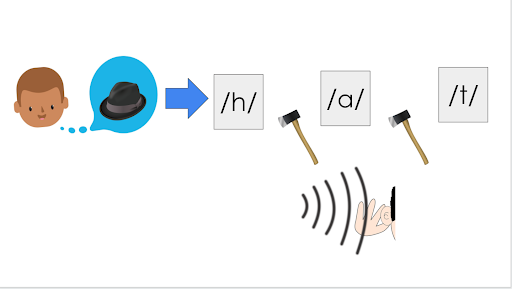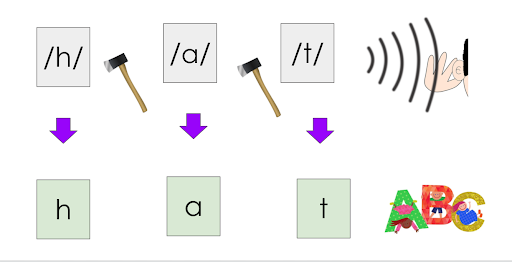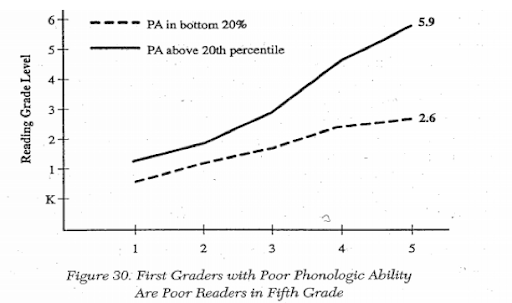Bridging Magic and Rocket Science with Explicit Phonemic Awareness Instruction
by Celestina Lee
As a 1st grade teacher, I’ve always thought the process of learning to read was magical. I’ve witnessed the incomparable joy of children going from reading highly repetitive texts in September to devouring chapter books in June. I’ve experienced those special moments when things just “click” as a student perseveres in decoding a word in a silly book and then lets out a belly laugh. But I’ve also seen some of the hardest working readers struggle through every CVC word in a text right up to the very end of 1st grade.
Each year, there were at least a handful of struggling readers in my room for whom whole group phonics instruction and guided reading were not effective. These students with persistent decoding difficulties forced me to acknowledge the limitations of my own understanding of literacy instruction and particularly, the cognitive underpinnings of how we develop as readers. In the fall of 2018, I was ready to add to my understanding of reading’s magic by delving into the “rocket science” side of teaching reading, as Dr.Louisa Moats describes it.
The importance of oral language
Through the support of my phenomenal instructional coach and the transformative clinical practicum at the DC Reading Clinic, I learned about the power of explicit phonemic awareness instruction. I’m embarrassed to admit that “phonemic awareness” was a term I threw around often during student teaching in undergrad, but then only thought about during mandatory benchmark assessments. I had a “PSF” tracker up on my wall, but did not actually understand how phoneme segmentation translated to my students’ decoding abilities.
I learned that our brains are wired for oral language, not print, so in order to successfully decode, students must first understand that words are made up of phonemes. We cannot take this understanding for granted, as the discovery of phonemes is NOT automatic (Dehaene, 2009), but must be explicitly taught (IES, 2019).

Extensive research from the National Reading Panel (2000) convened by Congress confirms the importance of children developing phonemic awareness, the ability to identify, isolate and manipulate these smallest units of sound. These skills are critical for children to then be able to easily match print to sound, crack “the code” and successfully read.

As Wiley Blevins (1997) explains, “Phonemic awareness training provides the foundation on which phonics instruction is built. Thus, children need solid phonemic awareness training for phonics instruction to be effective”(p.6). For years I had unknowingly rushed my students toward phonics without helping them build this essential foundation. It was no wonder it often felt like letter knowledge wasn’t “sticking” and CVC reading remained a struggle from day to day.
I also learned about the urgent predictive power of early phonemic awareness skills. In her exploration of dyslexia, Shaywitz (2003) reveals the correlation between weak phonological ability in first grade and below grade-level reading in fifth grade. Her work struck me as particularly critical when I learned that dyslexia, the most common reading disability, is typically rooted in phonological weaknesses. Phonemic awareness instruction in first grade has the potential to transform students’ academic trajectories and close reading gaps while they are narrow and potentially, before they even form.

Shifting instruction, maintaining the magic
Whole group
In response to this critical research, my school implemented a phonemic awareness curriculum called Heggerty in Pre-K through 1st grade. Heggerty lessons take no more than ten minutes, but provide students with practice for up to 9 phonemic tasks each day. These “word games” -as my students call them- quickly became our absolute favorite part of the day. Heggerty is joyful instruction…and not just because kids get to use fun hand movements and do silly cheers between tasks! Even the most emergent readers in my class feel successful as they leverage the power of their oral language skills. My students truly beam with pride while blending words with their “choppers” or deleting phonemes with their little palms in the air. Phonemic awareness instruction builds confidence and invites students to draw on their existing strengths, instead of demoralizing them with leveled texts which we have not yet adequately prepared them to tackle.

Using our “choppers” to blend and segment words!
Small group
It can be difficult to hear and watch every student during whole group Heggerty instruction, so I used the first 5-7 minutes of each of my small groups for additional PA instruction. This allowed me to provide targeted corrective feedback and modeling. I also utilized many of the multisensory tools I had been introduced to at the DC Reading Clinic, including phoneme chips, felts and elkonin boxes, which students LOVE!
The proof is in the pudding
Integrating the rocket science of phonological development into my instruction had profound effects on me as a teacher, but most importantly, transformed reading outcomes for my students. Prior to implementing Heggerty, I saw limited phoneme segmentation growth, especially for my students significantly below grade level (see SY 18-19 data). After Heggerty instruction in the 2019-2020 school year, 89% of my students were meeting benchmark for PSF by January and none remained significantly below grade level. Explicit instruction benefited all my students; not just the ones I was concerned about, as many students on grade-level at BOY were actually able to test out of PSF completely.
Due to the pandemic, we were unable to assess end-of-year outcomes. Still, given the fact that weaknesses in phonemic awareness are the most common source of word-reading difficulties (Reading Rockets, 2018), I was comforted by the knowledge that nearly all my students were now on an equal phonemic playing field to acquire print and read. Students may enter school with gaps in their phonological knowledge for myriad reasons, but intentional PA instruction, steeped in cognitive development, is one key lever in ensuring equitable reading access for all students.


The instruction our students deserve
Phonemic awareness instruction has been transformational for me and my students. This learning inspired me to continue my structured literacy journey and pursue a Masters in Literacy and Languages at Harvard Graduate School of Education this year. I’m relishing every second of nerding out about language acquisition and atypical cognitive development, but I’m also incredibly eager to get back to my enthusiastic little word segmenters and skilled phoneme manipulators! All of the theory and research I encounter affirms what I saw in practice- that effective reading instruction must explicitly address phonemic awareness. Every student deserves access to evidence-based teaching that will help unlock the magical world of reading.
References:
Blevins, W. (1997). Phonemic awareness activities for early reading success: Easy, playful activities that help prepare children for phonics instruction. Scholastic.
National Reading Panel. (2000). Teaching Children to Read: An Evidence-Based Assessment of the Scientific Research on Reading and Its Implications for Reading Instruction. Reports of the Subgroups. Author. 2.1-2.8
Shaywitz, S. E., & Shaywitz, J. (2020). Overcoming dyslexia.

Celestina Lee is a 1st grade teacher with DC Public Schools. She is currently pursuing her Masters in Literacy and Languages at Harvard Graduate School of Education. She is particularly interested in the intersections of structured literacy and culturally-sustaining instructional practices. She is currently reading The Vanishing Half by Brit Bennett.